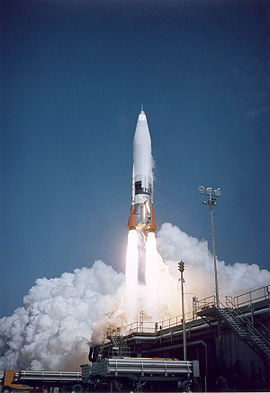SM-65A Atlas

Launch of Atlas 10A from LC-12 at CCAS
|
|
| Function | Prototype ICBM |
|---|---|
| Manufacturer | Convair |
| Country of origin | United States |
| Launch history | |
| Status | Retired |
| Launch sites | LC-12 & LC-14, CCAFS |
| Total launches | 8 |
| Successes | 4 |
| Failures | 4 |
| First flight | 11 June 1957 |
| Last flight | 3 June 1958 |
The Convair SM-65A Atlas, or Atlas A, also designated X-11 was the first full-scale prototype of the Atlas missile, which first flew on 11 June 1957. Unlike later versions of the Atlas missile, the Atlas A did not feature the stage and a half design. Instead, the booster engines were fixed in place, and the sustainer engine was omitted. The propulsion system produced a mere 135,000 pounds of thrust compared with the 360,000 pounds of the fully operational Atlas D.
The first three Atlases built were used merely for static firing tests with Missile 4A being the first flight article. It was delivered to Cape Canaveral in December 1956 and erected on LC-14 in March 1957, where it sat until the following summer. On June 11, 1957, the Atlas made its maiden voyage. Engine start proceeded normally and the launcher release system also functioned properly. All went well until T+26 seconds when the B-2 engine lost thrust, followed two seconds later by the B-1 engine. The Atlas reached a peak altitude of 9800 feet (2900 meters) and tumbled end-over-end through its own exhaust trail until T+50 seconds when the Range Safety officer sent the destruct command.
Analysis of telemetry data confirmed that the Atlas had malfunctioned due to hot exhaust gases being recirculated into the thrust section, which burned through wiring and caused loss of thrust. The pneumatic system also malfunctioned as tank pressure never properly transitioned to in-flight levels and along with propellant flow and pressure steadily decreased during ascent. The flight was considered a partial success because the missile had otherwise performed well. In particular, the Atlas's inflated balloon structure, which engineers doubted would even fly at all, had held together as the missile tumbled. The flight control system also worked well as it tried in vain to correct the missile's flight path.
Convair engineers decided that the Atlas needed a heat shield in the thrust section more substantial than the thin fiberglass one included on the missile. They proposed a modified heat sink made from steel and fiberglass, but the Air Force rejected that idea as the shield would be extremely heavy and also complicate booster section staging on operational Atlases. In addition, the pneumatic system was modified to vent inert helium gas down into the thrust section to reduce the risk of fire.
On September 25, Missile 6A was launched. Aside from more instrumentation in the thrust section and the above-mentioned helium vent modification, it was identical to 4A and predictably met the same fate as once again, the thrust section overheated, causing wiring to burn through. Thrust levels in both engines dropped to only 35% at T+32 seconds and two seconds later, the propulsion system completely shut down. The range safety destruct command was sent at T+63 seconds. This time, overheating had caused a LOX regulator to fail, resulting in gas generator flameout. After this debacle, the Air Force relented and accepted the need for an improved heat shield. Other modifications were made as well, including removal of the long skirt covering the boattail and engine nozzles. The gas generator vent pipe was also changed to point outward and away from the missile instead of directly underneath it. The engine nozzles were covered with fiberglass insulation boots and aluminum plumbing in the Atlas was changed to steel plumbing which had a greater heat tolerance.
...
Wikipedia
